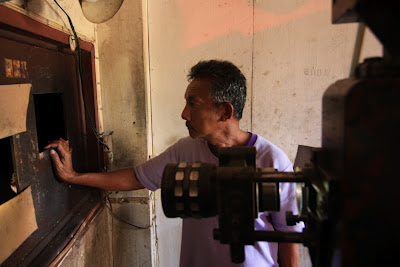It's a new ball game now. At least for the time being I have decided to spend some time in America, without any immediate prospects of a return to Southeast Asia. Believe me, this is a painful adjustment. And nothing pains me more than not being able to work this project (I've tried documenting American movie theaters, but I can't muster the same devotion to it).
So an indefinite lull in activity awaits, but by no means is this the end of the Southeast Asia Movie Theater Project. To the contrary, I have a bunch of irons in the fire as I type. Besides my usual attempts to land grants and fellowships, I am slowly piecing together a book about the stand-alone theaters of Burma. That's still a ways from completion, but it is in the works nonetheless.
As some of you may already be aware, there is currently a series of SEA Movie Theater Project photos on display at Bangkok's Jim Thompson Art Center. That will be running to through October. Please check it out if you want to view these images in large print format and in a context other than a computer screen.
The people at Jim Thompson, I ought to mention, have been consistently supportive of this work. Without them I do not think it would have been able to survive as long as it has. They are a saintly group to whom I owe a debt of gratitude.
The Lifescapes Southeast Asia Film Fest, the Busan International Film Fest, the Luang Prabang Film Fest and the Cinemanila International Film Fest have also been extremely good to me and deserve much praise. So does his Wiseness over at Wise Kwai's Thai Film Journal, who has generously promoted this project from the start.
As for future events, December of this year includes another exhibition, this time in Jakarta, Indonesia at the Chop Shots Documentary Film Festival. There very well may be something exciting in conjunction with that, which I'll keep you all abreast of.
In the meantime, thanks for all the visits and page views, the supportive comments and fan mail. Check back from time to time to see if anything new is in the works. Send in your own photos of stand-alone theaters in Southeast Asia if you feel so inspired. Or feel free to drop me a note: sea.theater@hotmail.com. It would be great to hear from you!
Warmly,
Phil





















